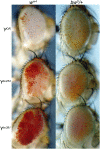Nucleolar dominance of the Y chromosome in Drosophila melanogaster
- PMID: 22649076
- PMCID: PMC3415996
- DOI: 10.1534/genetics.112.141242
Nucleolar dominance of the Y chromosome in Drosophila melanogaster
Abstract
The rDNA genes are transcribed by RNA polymerase I to make structural RNAs for ribosomes. Hundreds of rDNA genes are typically arranged in an array that spans megabase pairs of DNA. These arrays are the major sites of transcription in growing cells, accounting for as much as 50% of RNA synthesis. The repetitive rDNA arrays are thought to use heterochromatic gene silencing as a mechanism for metabolic regulation, since repeated sequences nucleate heterochromatin formation in eukaryotes. Drosophila melanogaster carries an rDNA array on the X chromosome and on the Y chromosome, and genetic analysis has suggested that both are transcribed. However, using a chromatin-marking assay, we find that the entire X chromosome rDNA array is normally silenced in D. melanogaster males, while the Y chromosome rDNA array is dominant and expressed. This resembles "nucleolar dominance," a phenomenon that occurs in interspecific hybrids where an rDNA array from one parental species is silenced, and that from the other parent is preferentially transcribed. Interspecies nucleolar dominance is thought to result from incompatibilities between species-specific transcription factors and the rDNA promoters in the hybrid, but our results show that nucleolar dominance is a normal feature of rDNA regulation. Nucleolar dominance within D. melanogaster is only partially dependent on known components of heterochromatic gene silencing, implying that a distinctive chromatin regulatory system may act at rDNA genes. Finally, we isolate variant Y chromosomes that allow X chromosome array expression and suggest that the large-scale organization of rDNA arrays contribute to nucleolar dominance. This is the first example of allelic inactivation in D. melanogaster.
Figures





Similar articles
-
Regulation of Nucleolar Dominance in Drosophila melanogaster.Genetics. 2020 Apr;214(4):991-1004. doi: 10.1534/genetics.119.302471. Epub 2020 Mar 2. Genetics. 2020. PMID: 32122935 Free PMC article.
-
Nucleolar dominance and replicative dominance in Drosophila interspecific hybrids.Genetics. 1989 Oct;123(2):349-58. doi: 10.1093/genetics/123.2.349. Genetics. 1989. PMID: 2511070 Free PMC article.
-
Chromosomal position effects reveal different cis-acting requirements for rDNA transcription and sex chromosome pairing in Drosophila melanogaster.Genetics. 2000 Jul;155(3):1195-211. doi: 10.1093/genetics/155.3.1195. Genetics. 2000. PMID: 10880481 Free PMC article.
-
The license to pair: identification of meiotic pairing sites in Drosophila.Chromosoma. 1996 Sep;105(3):135-41. doi: 10.1007/BF02509494. Chromosoma. 1996. PMID: 8781181 Review.
-
rRNA gene silencing and nucleolar dominance: insights into a chromosome-scale epigenetic on/off switch.Biochim Biophys Acta. 2007 May-Jun;1769(5-6):383-92. doi: 10.1016/j.bbaexp.2007.02.005. Epub 2007 Mar 12. Biochim Biophys Acta. 2007. PMID: 17439825 Free PMC article. Review.
Cited by
-
Integration, Regulation, and Long-Term Stability of R2 Retrotransposons.Microbiol Spectr. 2015 Apr;3(2):MDNA3-0011-2014. doi: 10.1128/microbiolspec.MDNA3-0011-2014. Microbiol Spectr. 2015. PMID: 26104703 Free PMC article. Review.
-
Transgenerational inheritance of diet-induced genome rearrangements in Drosophila.PLoS Genet. 2015 Apr 17;11(4):e1005148. doi: 10.1371/journal.pgen.1005148. eCollection 2015 Apr. PLoS Genet. 2015. PMID: 25885886 Free PMC article.
-
Monoallelically expressed noncoding RNAs form nucleolar territories on NOR-containing chromosomes and regulate rRNA expression.Elife. 2024 Jan 19;13:e80684. doi: 10.7554/eLife.80684. Elife. 2024. PMID: 38240312 Free PMC article.
-
Reaching for the off switch in nucleolar dominance.Plant J. 2023 Sep;115(5):1185-1192. doi: 10.1111/tpj.16318. Epub 2023 Jun 2. Plant J. 2023. PMID: 37228042 Free PMC article.
-
Mechanisms of rDNA Copy Number Maintenance.Trends Genet. 2019 Oct;35(10):734-742. doi: 10.1016/j.tig.2019.07.006. Epub 2019 Aug 5. Trends Genet. 2019. PMID: 31395390 Free PMC article. Review.
References
-
- Ahmad K., Henikoff S., 2002. The histone variant H3.3 marks active chromatin by replication-independent nucleosome assembly. Mol. Cell 9: 1191–1200 - PubMed
-
- Anguera M. C., Sun B. K., Xu N., Lee J. T., 2006. X-chromosome kiss and tell: how the Xs go their separate ways. Cold Spring Harb. Symp. Quant. Biol. 71: 429–437 - PubMed
-
- Durica D. S., Krider H. M., 1977. Studies on the ribosomal RNA cistrons in interspecific Drosophila hybrids. I. Nucleolar dominance. Dev. Biol. 59: 62–74 - PubMed
Publication types
MeSH terms
Substances
Grants and funding
LinkOut - more resources
Full Text Sources
Molecular Biology Databases

